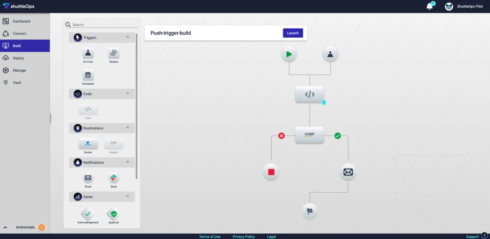
The new drag-and-drop functionality by ShuttleOps enables developers to build and deploy Docker container images to self-managed or hosted Kubernetes clusters.
According to the company, this helps with managing application runtime configurations and automating application delivery across all of the major cloud platforms: AWS, Azure, and GCP.
Users can now link to Docker container registries and Kubernetes clusters from their ShuttleOps accounts, leveraging familiar build and deploy pipelines with comprehensive application management capabilities.
“With ShuttleOps, organizations are able to standardize service infrastructure across the entire pipeline, eliminating delays, failures and conflicts by replacing time-consuming manual tasks and unmaintainable scripts,” the company wrote in a post. “ShuttleOps eliminates the need to select and train operations staff on disparate artifact management, secret management, cloud, container, deployment and configuration management technologies.”
ShuttleOps also now offers many other no-code multicloud Kubernetes capabilities.
New features include YAML-free deployment from Docker container registries to Kubernetes clusters and advanced Kubernetes configuration support for ConfigMaps, Secrets, and Ingress Controllers.
It also offers support for the global management of environment variables and container arguments, intelligent rolling deployment support for Kubernetes, and at-a-glance visibility into the state of Kubernetes applications and environments.
ShuttleOps secures application secrets and configures cloud firewalls. It also supports Chef Habitat for packaging and delivery of non-containerized applications.
ShuttleOps helps IT organizations address the biggest challenge they face today — the application delivery gap between Dev and Ops,” said David Found, the CEO of ShuttleOps. “By helping to establish standard practices and unify tool sets across teams, regardless of coding expertise, we are able to reduce complexity and accelerate time-to-value. Our new container capabilities enable teams to eliminate external services for DevOps strategies and solutions, and allow them to focus on building the next generation of software to take their business into the future.”






